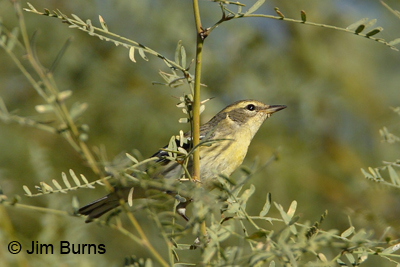
Checking my email after work on Wednesday, October 17, I find a posting to the Arizona/New Mexico birders' listserv that a Blackburnian Warbler has been found in Scottsdale's Eldorado Park. This eastern warbler named for Anna Blackburne, an eighteenth century English botonist, typically migrates east of the Mississippi and is seldom seen in Arizona. For state listers this scenario defines the ultimate treasure hunt. But it is already after dark and I am buried with work the next day. This bird will have to stay until Friday for me to have a chance.
At work on Thursday I ride that roller coaster all day. Will it leave? Will it be found again today? There is good news--no change in weather is predicted, so it should stay. But, that's also the bad news--warblers migrate on clear nights and there will be no cloud cover, so it might take off. The park is near my house, but this is a five inch needle in a block wide by four block long haystack. The breeding male Blackburnian is among our most spectacular warblers, flame colored face and throat with a black mask, but the Eldorado bird is a first fall female, pale yellow replacing the orange, the mask only a smudge of brown. Even if I'm lucky and it stays, are my birding skills good enough to find it, let alone identify it?
Thursday evening I rush home to open my email. The bird has been seen again that morning, but it took searchers 45 minutes to find as it flipped through dense foliage gleaning breakfast insects in company with several not dissimilar looking yellow-rumped warblers. Forty-five minutes--a pittance of time if you have all day, an eternity if you're on your way to work.
Friday morning I am at Eldorado as the sun hits the treetops, activating the bugs. There are six of us: a good friend who was over to dinner last month; two old friends I haven't seen since the last rarity chase; a birder I know by name only; and one I've never seen before in my life. Initially we hang together, sorting through the yellow-rumps and orange-crowneds. Then slowly we drift apart, urgency and frustration silently dictating we broaden the search area.
We are nearly out of shouting range now, joggers and dog walkers between us. I am competitive enough I would love the unspoken bragging rights of finding the bird for my friends, but I also know to watch them every few minutes with my binoculars to assess their body language. Across a pond I see two of them coalesce, point excitedly, and glass intently into a mesquite. Immediately I begin running. They have the bird, they put me on it, I see its diagnostic field marks. I turn and look for the next nearest birder, step away from the tree a few paces and wave him over. The small flock of feeding warblers is oblivious.
With minutes the six of us are in a silent circle around the tree, binoculars raised. Softly we share thanks and congratulations. Reserved high fives are exchanged. This is better than . . . . Well, actually, no it's not, but it feels like it right now. For listers this is as good as birding gets.